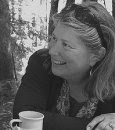
Before I began the first leg of the walk I visited the Oakland Museum, now called the Oakland Museum of California. The OM opened in 1969 to deserved fanfare; the building is innovative and alone worth a visit. The art, natural history and historical collections are fantastic and they place so much material wealth of art and artifact into a context that is sweeping and eye opening. The OM Natural History exhibit may have been the real genesis of the notion of seeing all of the state in fine scale.
A school field trip had introduced me for the first time to the incomparable “A Walk Across California” exhibit when I was about ten or eleven years old. This display of animals and plants in dioramas and laden cases highlighted what could be discovered in a cross transect exploration of California’s nature from the mid-coast to the Nevada border’s Basin and Range environments. Having tromped the East Bay Hills daily, Sunday-driven to the coast, and backpacked four times, for weeks at a time, in the alpine Sierra by the ripe age of ten this place was full of old friends in its frozen flying gulls, shellacked coyote brush, and taxidermied black bear. I visited the Natural History exhibit many times in my youth, and frequently as an adult, usually after catching one of the great temporary shows this museum presents. The game has always been to find the species I had seen myself, with a compelling yearning to see the ones I hadn’t.
On the day I recently visited the museum, a sentimental sort of “where it all began” exercise, there were about six OM staffers hanging about expectantly with clipboards. My innate resistance to questionnaires and a few avoidance moves allowed me to hurry past their greatest density around the large three-dimensional map of the state. This overview of my intended walk was so full of topography it was best left unexamined to prevent discouragement. The exhibit began with a Coast exhibit. I knew I was not going to start at the coast so I perused more richly the Outer Coast Range exhibit with characteristic redwoods, steller’s jays and Doug iris, through the Inner Coast Range, the holder of the classic oak-dotted, hot grass and chaparral swathed slopes of places like Mt. Diablo and the sere ramparts of the western Central Valley. Then through the Central Valley, my current birdwatching Mecca, a place of heat, flat water and agriculture-with-a-capital-C. I continued on through the Western Sierran Slope, which the museum breaks into two biotic zones, the Sierran Slope Foothills, and the Sierran Slope Snowbelt. The first zone is a place remembered for huge fast rivers and the smell of pines in the heat. The alpine High Sierra was a summer playground for my family. Then from the imaginary height of the precipitous eastern escarpment (I have always loved that word) we pass down again into the desert-like playas and White Mountains of the far east of California. A mere hour and my Walk Across California was complete. If only…
On the way back out of the exhibit my curiosity and semi-polite manners succumbed to the eager hopefulness of the assigned interrogators with clipboards. A woman in her twenties asked me what my favorite places in California were, what I liked best about the exhibit etc. She probably would never have found a more prompted, ready-with-an-answer person than me; someone who was at that very moment thinking hard about what the museum and California means to her, in particular its natural legacy. I asked her after she finished why she was asking and she said that the Natural History exhibit was going to be redesigned completely and this was a day for visitor input. She really could not engage me in my questions about the design that were above and beyond the questionnaire and referred me to one of the design coordinators for the museum who was sitting off to the side.
I introduced myself as someone who really loved the current exhibit and went into its inspirational effects on me as a child and to this day, including my mega-walk. She spoke of the need for the exhibit to be less curator-driven and more visitor-driven in its displays. There would be re-creations of places that people were familiar with (hence the questioning of visitors for places that were meaningful), and so there might be a Yosemite, or Ano Nuevo display. There would also be an exhibit on the threats to these wild treasures. I defended briefly the motivational aspect that a curator or teacher’s vision can impart, but I also knew that all museums were changing in these ways. Just as the landscape of California itself has sloughed off its old uses to a great degree, progress has given us “real estate” –that now looks more homogenous and visitor driven too – in its malls, tract homes and other highway-side conveniences.
I liked the fact that the original display was a bounty of possibilities in full array. None of the exhibits became too familiar over the years because they were esoteric in their number of things presented. Those things presented were not portrayed as so fragile that my emotions were battered by hints of imminent demise. I didn’t feel personal responsibility, just wonder. The old exhibit helped me to love what I was seeing, to want to get more intimate with the weirder denizens I had overlooked, and put the whole carpet of ecological communities in context for me, for life. The exhibit’s last day is August 23, 2009 and I recommend all to go see it, again.






